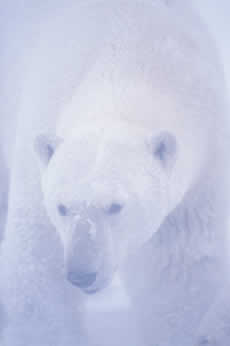Ringed Seals
Favored prey of polar bears
Ringed seals are the most common seals in the Arctic—and the polar bear’s chief prey. They spend their entire lives on, around, or under the sea ice and have thick layers of blubber to keep them warm.
A life cycle tied to the ice
In early spring, mother seals give birth in snow dens dug over breathing holes in the ice. In May and June, they crawl onto ice floes to bask in the sun and undergo their annual molt, raising their heads frequently to check for danger. In late fall and winter, they live under the sea ice and breathe through long, tubular holes maintained through the ice.
How the seals are hunted
Polar bears can sniff out these holes from close to a mile away. Their hunting strategies are ingenious: they may sneak up on a seal basking near a hole and pounce, or they may break through a snowdrift into the seal’s birth lair below, catching the seal with their jaws. |

Male polar bear in an autumn snowstorm (coastal plain, Arctic National Wildlife Refuge)
Photograph by Steven Kazlowski
|

